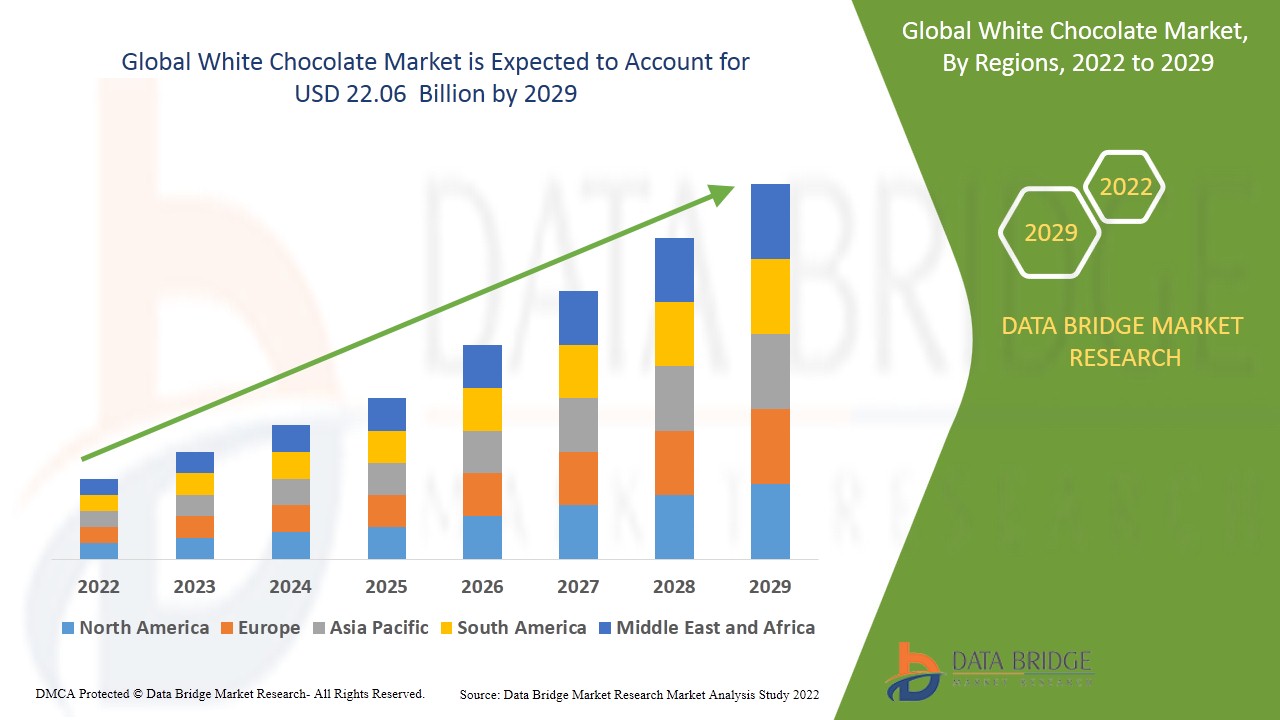

Executive Summary White Chocolate Market :
Global white chocolate market size was valued at USD 19.60 billion in 2024 and is projected to reach USD 23.69 billion by 2032, with a CAGR of 2.40% during the forecast period of 2025 to 2032.
The analysis and estimations conducted via the winning White Chocolate Market report help to get an idea about the product launches, future products, joint ventures, Market strategy, developments, mergers and acquisitions and effect of the same on sales, Market, promotions, revenue, import, export, and CAGR values. The industry analysis report assists in determining and optimizing each stage in the lifecycle of industrial process that includes engagement, acquisition, retention, and monetization. This comprehensive report has estimations of CAGR values which are very important for businesses in deciding upon the investment value over the time period. White Chocolate Market report examines market drivers, market restraints, challenges, opportunities and key developments in the industry.
The high quality White Chocolate Market document contains market insights and analysis for industry which are backed up by SWOT analysis. This report provides a broader perspective of the market place with its comprehensive market insights and analysis which eases surviving and succeeding in the market. Moreover, such market report explains better market perspective in terms of product trends, Market strategy, future products, new geographical markets, future events, sales strategies, customer actions or behaviours. White Chocolate Market research report encompasses a far-reaching research on the current conditions of the industry, potential of the market in the present and the future prospects.
Discover the latest trends, growth opportunities, and strategic insights in our comprehensive White Chocolate Market report. Download Full Report: https://www.databridgemarketresearch.com/reports/global-white-chocolate-market
White Chocolate Market Overview
The global white chocolate market is experiencing a notable shift towards organic products, driven by the increasing consumer preference for natural and healthier options. Organic white chocolate is gaining traction due to factors such as clean label trends, sustainability concerns, and health consciousness among consumers. This segment not only caters to the traditional chocolate lovers but also attracts health-conscious individuals looking for premium and ethically sourced indulgences. Market players are capitalizing on this trend by introducing organic white chocolate variants and emphasizing their sustainable sourcing practices to appeal to a broader customer base.
In terms of form, the white chocolate market is witnessing a surge in demand for convenient formats such as bars, chips, and chunks. These ready-to-use forms offer consumers versatility in using white chocolate for various culinary applications, from baking to snacking. The convenience factor associated with these products aligns with the busy lifestyles of modern consumers who seek on-the-go indulgences without compromising on taste or quality. Furthermore, the availability of white chocolate in different forms allows manufacturers to target different consumer segments and applications, thereby expanding their market reach and driving overall market growth.
The distribution channels for white chocolate have also evolved to meet the changing consumer shopping behaviors and preferences. While supermarkets/hypermarkets have traditionally been the key retail channels for chocolate products, the rise of convenience stores and online retail has opened up new avenues for white chocolate sales. The convenience of purchasing white chocolate products online and the growing popularity of e-commerce platforms have enabled consumers to explore a wider range of options and make informed purchase decisions. This shift towards online retail is also creating opportunities for market players to enhance their digital presence, engage with consumers directly, and tap into the global market reach.
From a geographical perspective, North America and Europe continue to dominate the white chocolate market, owing to their established chocolate consumption cultures and strong demand for premium confectionery products. These regions are characterized by a mature chocolate market, well-developed distribution networks, and a high level of disposable income among consumers, making them lucrative markets for white chocolate manufacturers. However, emerging economies in Asia-Pacific, South America, and the Middle East & Africa present untapped growth opportunities for market players due to rising disposable incomes, urbanization, and a growing preference for Western food trends. By expanding their presence in these regions and adapting their product offerings to local tastes and preferences, companies can capitalize on the increasing consumer demand for white chocolate in these markets.
Overall, the global white chocolate market is poised for continued growth and innovation as consumer preferences evolve, and market players adapt to changing industry dynamics. By focusing on product diversification, sustainability initiatives, and strategic partnerships, companies can stay ahead of the competition, capture new market segments, and drive long-term success in the ever-changing confectionery landscape.The global white chocolate market is witnessing a notable shift towards organic and natural products driven by the increasing consumer preference for healthier indulgences. The rising awareness about clean label trends, sustainability practices, and health consciousness is fueling the demand for organic white chocolate variants. Market players are strategically introducing organic options to cater to a broader customer base, appealing not only to traditional chocolate enthusiasts but also to health-conscious individuals seeking premium and ethically sourced treats. This trend towards organic white chocolate signifies a significant opportunity for manufacturers to capitalize on evolving consumer sentiments and enhance their market presence.
In terms of product forms, the white chocolate market is experiencing a surge in demand for convenient formats such as bars, chips, and chunks. These ready-to-use forms offer consumers versatility in using white chocolate across various culinary applications, from baking to snacking. The convenience factor associated with these products aligns well with the busy lifestyles of modern consumers who seek on-the-go indulgences without compromising on quality. Manufacturers are leveraging this trend by diversifying their product offerings, targeting different consumer segments, and expanding their market reach. By offering white chocolate in diversified forms, companies can tap into new market opportunities and drive overall market growth.